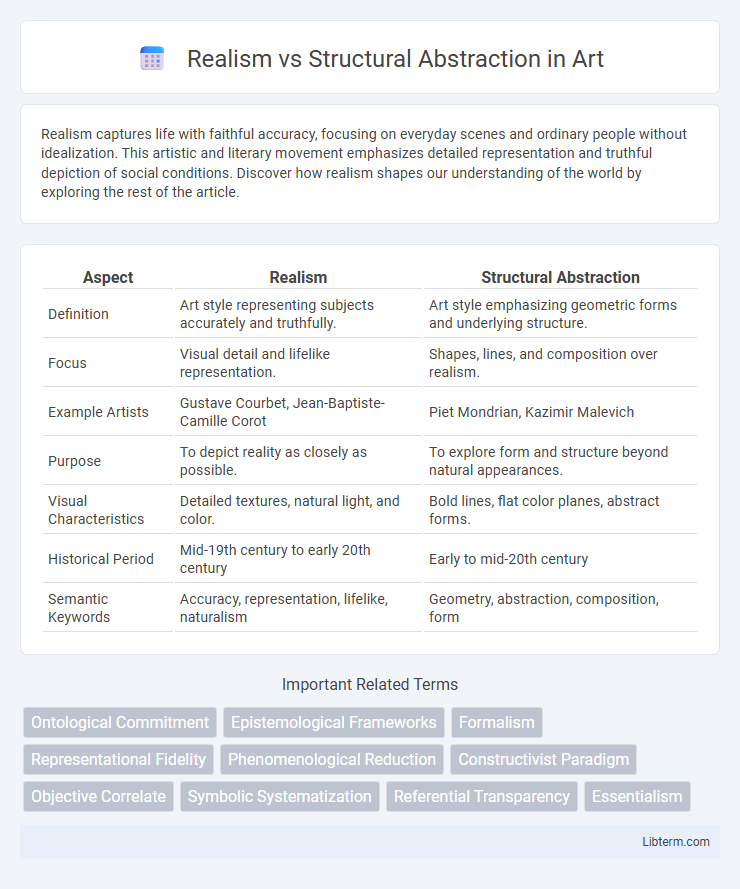Realism captures life with faithful accuracy, focusing on everyday scenes and ordinary people without idealization. This artistic and literary movement emphasizes detailed representation and truthful depiction of social conditions. Discover how realism shapes our understanding of the world by exploring the rest of the article.
Table of Comparison
| Aspect | Realism | Structural Abstraction |
|---|---|---|
| Definition | Art style representing subjects accurately and truthfully. | Art style emphasizing geometric forms and underlying structure. |
| Focus | Visual detail and lifelike representation. | Shapes, lines, and composition over realism. |
| Example Artists | Gustave Courbet, Jean-Baptiste-Camille Corot | Piet Mondrian, Kazimir Malevich |
| Purpose | To depict reality as closely as possible. | To explore form and structure beyond natural appearances. |
| Visual Characteristics | Detailed textures, natural light, and color. | Bold lines, flat color planes, abstract forms. |
| Historical Period | Mid-19th century to early 20th century | Early to mid-20th century |
| Semantic Keywords | Accuracy, representation, lifelike, naturalism | Geometry, abstraction, composition, form |
Introduction to Realism and Structural Abstraction
Realism emphasizes accurate, detailed representation of subjects to reflect everyday life and natural settings, capturing textures, light, and forms precisely. Structural abstraction simplifies and distills shapes and forms into geometric patterns, focusing on underlying structures rather than surface details. Both approaches define distinct artistic explorations, with realism rooted in fidelity to reality and structural abstraction in conceptual and visual reduction.
Historical Development of Realism
Realism emerged in the mid-19th century as a reaction against Romanticism, emphasizing accurate, detailed depictions of everyday life and social conditions, particularly influenced by artists like Gustave Courbet and Jean-Francois Millet. This movement sought to portray the world without idealization, reflecting the political upheaval and scientific advancements of the Industrial Revolution era. Structural Abstraction developed later in the 20th century, shifting focus from representational accuracy to geometric forms and abstract relationships, challenging traditional perspectives established by Realism.
Origins and Evolution of Structural Abstraction
Structural abstraction emerged in the early 20th century as a response to the limitations of Realism, emphasizing simplified geometric forms and spatial relationships over detailed representation. Influenced by movements such as Cubism and De Stijl, artists like Piet Mondrian and Kazimir Malevich pioneered this approach by breaking down objects into basic shapes and colors to convey universal concepts. The evolution of structural abstraction progressed through Abstract Expressionism and Minimalism, continually refining its focus on form, structure, and underlying order rather than visual accuracy.
Key Principles of Realism in Art
Realism in art emphasizes accurate, detailed, and unembellished depiction of nature and contemporary life, focusing on ordinary subjects rather than idealized or romanticized versions. Key principles include a commitment to portraying everyday scenes with truthful representation, including imperfections, light, and texture as observed in reality. Artists like Gustave Courbet pioneered this approach, challenging previous artistic conventions by rejecting exaggerated emotionalism and abstract interpretations.
Core Concepts of Structural Abstraction
Structural Abstraction centers on representing complex systems by focusing on the relationships and interactions between components rather than their detailed physical attributes, enabling clearer problem-solving and system design. This approach emphasizes hierarchical organization, modularity, and encapsulation to manage complexity and improve maintainability in software engineering and modeling. Core concepts include abstraction layers, interfaces, and data encapsulation, which allow developers to focus on system behavior and structure without being distracted by implementation specifics.
Major Artists and Their Contributions
Gustav Courbet pioneered Realism by depicting everyday scenes with unidealized accuracy, challenging romanticized conventions. In Structural Abstraction, artists like Piet Mondrian advanced the movement by reducing forms to geometric shapes and primary colors, emphasizing order and harmony. Both movements influenced modern art by redefining representation--Realism through truthful depiction and Structural Abstraction through formal simplification.
Techniques and Mediums Used
Realism employs techniques like precise brushwork, detailed textures, and accurate light representation using traditional mediums such as oil paint, graphite, and watercolor to achieve lifelike depictions. Structural Abstraction, conversely, utilizes geometric shapes, simplified forms, and bold lines, often created through mixed media including acrylics, collage, and digital tools to emphasize underlying structures. Both approaches manipulate composition and color theory but diverge fundamentally in their aim: Realism seeks faithful representation while Structural Abstraction prioritizes conceptual interpretation.
Visual Impact and Viewer Interpretation
Realism captures detailed, lifelike visuals that provide clarity and direct recognition, enhancing immediate viewer comprehension and emotional connection. Structural abstraction breaks down forms into geometric shapes and patterns, encouraging viewers to interpret meaning beyond literal representation through subjective analysis. The visual impact of realism lies in its explicit depiction, while structural abstraction prompts deeper cognitive engagement and diverse interpretations.
Realism vs Structural Abstraction: Comparative Analysis
Realism emphasizes accurate, detailed representation of subjects as they appear in life, capturing textures, lighting, and proportions with high fidelity. Structural Abstraction prioritizes the underlying geometric forms and spatial relationships, often simplifying or distorting natural appearances to highlight composition and design principles. Comparative analysis reveals that while Realism seeks to replicate visual reality, Structural Abstraction interprets reality through the lens of form and structure, influencing artistic intention and viewer perception distinctively.
Contemporary Relevance and Future Trends
Realism emphasizes lifelike representation and detailed accuracy, which remains influential in contemporary art circles valuing authenticity and emotional connection. Structural Abstraction, characterized by geometric shapes and simplified forms, continues to shape modern design, digital media, and architecture, reflecting technological advancements and minimalist aesthetics. Future trends indicate a hybrid approach, merging realistic textures with abstract structures through augmented reality and AI-generated art, pushing creative boundaries and audience engagement.
Realism Infographic

 libterm.com
libterm.com